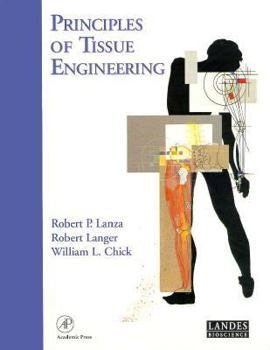Principles of Tissue Engineering
Select Format
Select Condition 
Book Overview
Now in its fifth edition, Principles of Tissue Engineering has been the definite resource in the field of tissue engineering for more than a decade. The fifth edition provides an update on this... This description may be from another edition of this product.
Format:Hardcover
Language:English
ISBN:0124366252
ISBN13:9780124366251
Release Date:December 1996
Publisher:Academic Press
Length:808 Pages
Weight:5.81 lbs.
Dimensions:2.0" x 8.8" x 11.2"
Customer Reviews
3 ratings
Covering the whole body
Published by Thriftbooks.com User , 22 years ago
This is a great book, covering most details of its field. It describes the physicians (and their patients) dream of substituting organs and cells and it also shows, how mankind could not solve problems ? up to now. History of artificial organs lacking the full function is one point, but the focus is on cells and their ability to build complete organs ? and therefore the book looks on the pathway for the future of organ substitution.The introduction covers some main ideas of tissue engineering ? what do we want ? what are we able to do ? what do we still have to get knowledge of. After a short review of the history, the essentials of cell biology (Growth, Differentiation) are being introduced. The reader should have an idea of developmental biology to be able to follow topics like induction and morphogenesis. The authors emphasize the importance of the extracellular matrix as one of organ-prosthesis? main building blocks (ECM = scaffold; cells = function; cell signalling = integration and physiology).The second part describes technical aspects of in-vitro organ synthesis: tissue culture and ECM, tissue culture und growth factors, bioreactors and vascularization. The third part continues with in-vivo techniques of organ reparation, exemplified by methods for substitution of the ECM of skin, peripheral nerves and meniscus.Parts 4 ? 6 develop models for the substitution of the ECM (Collagen, BioPolymers), their implantation in the receiving organism and the resulting immunologic problems (emphasized).Parts 7 ? 20 are concerned with the organs themselves. After few words about stem cells and gene therapy the book explains reconstruction and substitution methods for breast, heart and blood vessels, Cornea, endocrine glands, liver (very good), kidney and haematopoietic system. Biomechanical problems are outlined in the part about the musculoskeletal system. On this place tissue engineering celebrates its oldest success (cartilage substitution). Today innervation processes are being focused.The book continues with substitutes for the senses (ear and eye), nerve cells, nerve regeneration and neural stem cells. Dents and skin could be all to make an ill patient ?healthy? by substitutes, one might think. But no, western medicine also knows something about substitutes for womb and placenta?On me the book made a good impression. The only point is: it?s quite too much text and too few pictures. It addresses medicals after their exams, practicing physicians and biologists. Chapters focus on the basic principles. There is a large number of links to more detailed publications.
Excellent textbook for students and researchers
Published by Thriftbooks.com User , 23 years ago
A vast, detailed summary of the latest advances in tissue engineering.
Excellent reference
Published by Thriftbooks.com User , 23 years ago
A few too many equations, but clearly the most comprehensive text in the field. Contributors list reads like a 'Who's Who' of tissue engineering.





